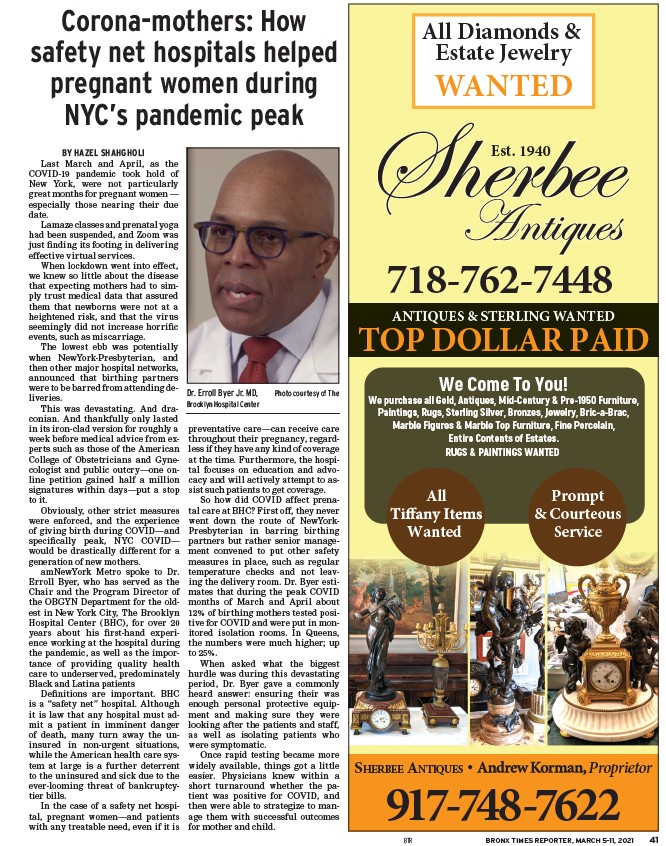
All Diamonds &
Estate Jewelry
WANTED
Est. 1940
718-762-7448
ANTIQUES & STERLING WANTED TOP DOLLAR PAID
We Come To You!
We purchase all Gold, Antiques, Mid-Century & Pre-1950 Furniture,
Paintings, Rugs, Sterling Silver, Bronzes, Jewelry, Bric-a-Brac,
Marble Figures & Marble Top Furniture, Fine Porcelain,
Entire Contents of Estates.
RUGS & PAINTINGS WANTED
All
Wanted
Prompt
& Courteous
Service
SHERBEE ANTIQUES Proprietor
917-748-7622
BRONX TIMES REPORTER, M BTR ARCH 5-11, 2021 41
Corona-mothers: How
safety net hospitals helped
pregnant women during
NYC’s pandemic peak
BY HAZEL SHAHGHOLI
Last March and April, as the
COVID-19 pandemic took hold of
New York, were not particularly
great months for pregnant women —
especially those nearing their due
date.
Lamaze classes and prenatal yoga
had been suspended, and Zoom was
just fi nding its footing in delivering
effective virtual services.
When lockdown went into effect,
we knew so little about the disease
that expecting mothers had to simply
trust medical data that assured
them that newborns were not at a
heightened risk, and that the virus
seemingly did not increase horrifi c
events, such as miscarriage.
The lowest ebb was potentially
when NewYork-Presbyterian, and
then other major hospital networks,
announced that birthing partners
were to be barred from attending deliveries.
This was devastating. And draconian.
And thankfully only lasted
in its iron-clad version for roughly a
week before medical advice from experts
such as those of the American
College of Obstetricians and Gynecologist
and public outcry—one online
petition gained half a million
signatures within days—put a stop
to it.
Obviously, other strict measures
were enforced, and the experience
of giving birth during COVID—and
specifi cally peak, NYC COVID—
would be drastically different for a
generation of new mothers.
amNewYork Metro spoke to Dr.
Erroll Byer, who has served as the
Chair and the Program Director of
the OBGYN Department for the oldest
in New York City, The Brooklyn
Hospital Center (BHC), for over 20
years about his fi rst-hand experience
working at the hospital during
the pandemic, as well as the importance
of providing quality health
care to underserved, predominately
Black and Latina patients
Defi nitions are important. BHC
is a “safety net” hospital. Although
it is law that any hospital must admit
a patient in imminent danger
of death, many turn away the uninsured
in non-urgent situations,
while the American health care system
at large is a further deterrent
to the uninsured and sick due to the
ever-looming threat of bankruptcytier
bills.
In the case of a safety net hospital,
pregnant women—and patients
with any treatable need, even if it is
Dr. Erroll Byer Jr. MD, Photo courtesy of The
Brooklyn Hospital Center
preventative care—can receive care
throughout their pregnancy, regardless
if they have any kind of coverage
at the time. Furthermore, the hospital
focuses on education and advocacy
and will actively attempt to assist
such patients to get coverage.
So how did COVID affect prenatal
care at BHC? First off, they never
went down the route of NewYork-
Presbyterian in barring birthing
partners but rather senior management
convened to put other safety
measures in place, such as regular
temperature checks and not leaving
the delivery room. Dr. Byer estimates
that during the peak COVID
months of March and April about
12% of birthing mothers tested positive
for COVID and were put in monitored
isolation rooms. In Queens,
the numbers were much higher; up
to 25%.
When asked what the biggest
hurdle was during this devastating
period, Dr. Byer gave a commonly
heard answer: ensuring their was
enough personal protective equipment
and making sure they were
looking after the patients and staff,
as well as isolating patients who
were symptomatic.
Once rapid testing became more
widely available, things got a little
easier. Physicians knew within a
short turnaround whether the patient
was positive for COVID, and
then were able to strategize to manage
them with successful outcomes
for mother and child.